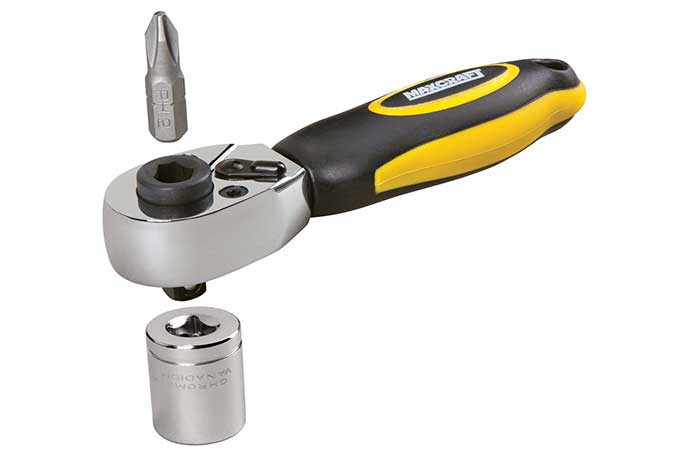1/4-Inch Dual-Drive Mini Ratchet Driver

Dual-drive head accepts 1/4-inch drive sockets and standard screwdriver bits
Inspired by the recent 1/4″ hex ratchet review, I am posting the one I use. Maxcraft is not a big name in tools, but this little guy is a gem. It is a chrome-plated, drop-forged chrome vanadium steel ratchet wrench with a cushion overmolded handle, 72-tooth ratchet gear (which is good), and BOTH a 1/4″ hex socket AND a 1/4″ square drive for sockets. It is tiny, about 4″ long. I got it for bicycle work.
Advantages:
- Unlike the wrench reviewed on Oct. 5, 2017, this one takes standard 1/4″ hex bits, the kind you already have spilling out of your toolboxes. That makes the bits easy and cheap to replace. It also gives you access to all sorts of weirdo bits you don’t need often, like Torx security, tri-point, Pozidrive, etc. Of course, a standard screwdriver-style bit holder will do that too, but not all of them ratchet, and this style offers far greater torque than the screwdriver-style handle.
- It is quite sturdy, being solid forged steel. Most other 1/4″ hex ratchets are riveted sheet steel. I have one of those too, but I never use it. It is wobbly and cheap-feeling.
- The 72-tooth ratchet gear means you only have to swing the wrench 5 degrees to get some progress. That is a feature of many high-quality ratchet wrenches, but is rare in such a small, cheap wrench.
- It is far more comfortable to use than the sheet-metal cheapies. With a tip like Torx or square drive that won’t cam out, you can really crank down with this thing, even though the handle is short. It is certainly powerful enough for bicycle work.
- The 1/4″ square drive is surprisingly handy. I got this wrench specifically to work on my bike, because I hate (really, really hate) standard L-shaped hex keys, which are flimsy, fixed angle, and to use them you have to remove and reinsert them repeatedly. Ball-end hex keys are better, but still have no torque.) But it turns out I couldn’t find a metric ball-head hex bit set with 1/4″ hex shafts. (They are available individually.) I could only find a set in 1/4″ “sockets.” So the socket drive turned out to be handy. Being able to ratchet ball-end hex bits is about 3 million times stronger, faster, and more convenient than the old L-shaped pieces of wire I used to use.
- It is cheap. It costs just over $6. There might be nicer wrenches from Chapman, Wiha, etc., but they cost more, and sometimes a lot more. On Amazon it is an “Add-on item,” meaning your total order has to be more than $25. I don’t find that a difficulty.
Disadvantages:
- It isn’t really low-clearance. The square drive socket shaft adds some depth to the head, so with a 1″ bit loaded, it is about 1 1/2″ from the tip of the bit to the tip of the socket shaft. It is also a little bulkier around the head than the sheet metal versions. So if I really needed a low-clearance model, I’d spend a bit more money for a nice Chapman set, or cheap out and get Neiko or MulWark. (I would have bought a Chapman set, but they don’t come with ball-end hex bits.) And for ultra-low clearance situations, there are drivers from Snap-On and others that look like tongue depressors with a tiny tip of a bit glued to one face. (They must be murder to use in Phillips or slotted, because it is impossible to put any downward pressure on the driver tip.)
- If it matters at all, it is heavier than the sheet-metal cheapies.
So in sum, it is a cheap, sturdy, comfortable, cheap, versatile, well-made, cheap wrench that uses cheap, varied and widely available 1/4″ bits, that is stronger but bulkier than the sheet metal ratchet wrenches. With the right bits it is so much better than those dinky L-shaped pieces of wire called hex “wrenches” that you will never look back.
10/10/17Maxcraft 60199 1/4-Inch Dual-Drive Mini Ratchet Driver ($6)









